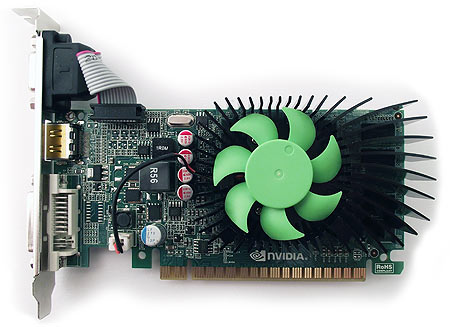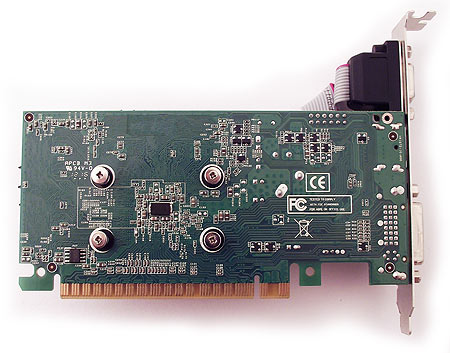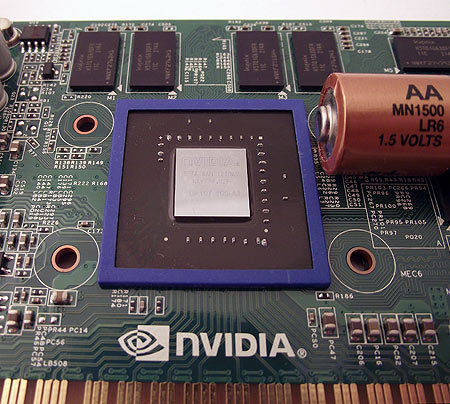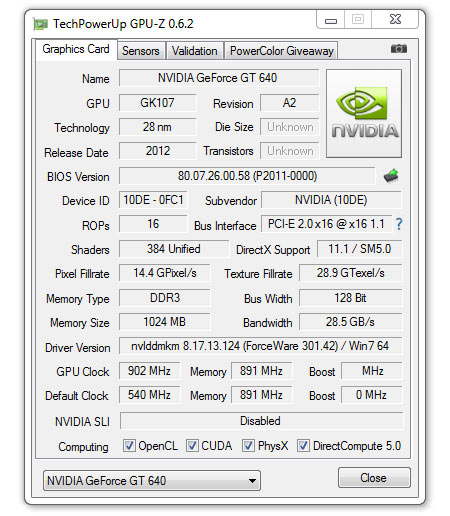Nvidia GeForce GT 640 Review: Cramming Kepler Into GK107
Afox sent us its rendition of the new GeForce GT 640, based on Nvidia's GK107 GPU. This one slots in under the existing GeForce GTS 450 to do battle with AMD's Radeon HD 6670. Does the Kepler architecture deliver, or is a $100 price target too high?
GeForce GT 640: Nvidia's Entry-Level Gambit
There was once a time when Nvidia and AMD would fight viciously to deliver the very best performance at every price point. Regardless of which company had the fastest flagship, they both managed to excel in specific segments. It was truly a great time to be a PC gamer. This golden age of tit-for-tat lasted a very long time, starting with the very first Radeon, which challenged Nvidia’s relatively new (at the time) GeForce 256.
Somewhere between Nvidia’s GeForce 200 and 400 generation, though, something changed. Even as the company maintained a strong portfolio above $150, Radeon cards began to dominate below the $100 price point. The potent GeForce 9600 GT was phased out in favor of the slightly slower GeForce GT 240, which in turn was replaced with a notably inferior GeForce GT 430. Radeon HD 5570 and 5670 cards held the upper hand in the entry-level market for a very long time, and we’ve seen so little competitive pressure that AMD now confidently sells the DDR3-equipped Radeon HD 6670 for the same price that the superior GDDR5-equipped Radeon HD 5670 used to cost. Performance per dollar is actually worse now than it was back then.
The best value in Nvidia’s low-end line-up is the GDDR5-equipped GT 440, essentially an overclocked GT 430 with a lot more memory bandwidth. Unfortunately, that’s a relatively low-volume specialty model a few vendors offer as a well-kept secret. And it’s typically a bit slower than the cheaper DDR3-equipped Radeon HD 6670 (On a side note, Nvidia has recently re-branded the GeForce GT 440 as the GeForce GT 630, but despite the name-change this card is still based on the older Fermi architecture).
We’ve been scratching our heads over this state of affairs for a very long time. Low-end value-oriented GPUs aren’t as sexy as flagships, but they represent a lot of volume and, done right, profit. We don’t have a speculative explanation to help understand why Nvidia’s sub-$100 line-up is lacking. But today the company is quietly slipping out a glimmer of hope in its GeForce GT 640. This is the first Kepler-based card we’ve seen with a GPU other than GK104. Instead, it employs GK107.
Measuring 118 mm², GK107 is about 40% as large as the 294 mm² GK104, and its 1.3 billion transistors represent close to 37% of the higher-end gaming GPU.
In essence, the GeForce GT 640’s GK107 features one-quarter of a fully-functional GK104’s shader resources. Those 384 CUDA cores are divided up into a pair of SMXes, each with 16 texture units (totaling 32). Nvidia sets the chip to run at 900 MHz. Lacking the GPU Boost functionality of the GK104-based boards, GeForce GT 640 cannot dynamically operate at higher clock rates when thermal headroom exists.
This GPU’s back-end consists of two ROP clusters, each able to output eight 32-bit pixels per clock, adding up to 16. Two corresponding 64-bit memory interfaces aggregate to 128-bits. And with 2 GB of DDR3 operating at 891 MHz, the card gets access to a meager 28.5 GB/s.
Get Tom's Hardware's best news and in-depth reviews, straight to your inbox.
The new architecture also enables a handful of features previously not available from Nvidia, including PCI Express 3.0 compatibility and Surround support across three monitors (the card actually supports up to four monitors in hardware, but we've been told that partners will typically include three outputs). In addition, it’s Nvidia’s first low-cost SKU based on a 28 nm GPU. To learn more about Kepler, read Chris Angelini’s GeForce GTX 680 launch article.
Nvidia rates the card with a 65 W thermal design power, which ducks in under the 75 W deliverable by a 16-lane PCI Express slot. As such, there are no auxiliary power connectors on the GeForce GT 640. Nevertheless, the reference design still employs a dual-slot form factor thanks to a thick GPU cooler.
More so than past derivative graphics processors from Nvidia, GeForce GT 640 looks like it could shake things up in the budget segment. The company is claiming its DDR3-equipped card is faster than the Radeon HD 6670 with GDDR5 and priced under $100. It doesn’t look like there’s currently a model with GDDR5 launching, but that could be an even more interesting proposition.
| Header Cell - Column 0 | GeForce GT 640DDR3 | Radeon HD 6670 | Radeon HD 7750 | GeForce GT 440(aka GeForce GT 630)GDDR5 | GeForce GTS 450 |
|---|---|---|---|---|---|
| Shader Cores | 384 | 480 | 512 | 96 | 192 |
| Texture Units | 32 | 24 | 32 | 16 | 32 |
| Color ROPs | 16 | 8 | 16 | 4 | 16 |
| Fabrication process | 28 nm | 40 nm | 28 nm | 40 nm | 40 nm |
| Core (Shader) Clock | 900 MHz | 650 MHz | 800 MHz | 810 (1620) MHz | 783 (1566) MHz |
| Memory Clock | 891 MHz DDR3 | 900 MHz DDR3 900-1000 MHz GDDR5 | 1125 MHz GDDR5 | 810 MHz GDDR5 | 902 MHz GDDR5 |
| Memory Bus | 128-bit | 128-bit | 128-bit | 128-bit | 128-bit |
| Memory Bandwidth | 28.5 GB/s DDR3 | 28.8 GB/s DDR3 64 GB/s GDDR5 | 72 GB/s | 51.8 GB/s | 57.7 GB/s |
| Idle/Max Thermal Design Power | 15/65 W | 10/44 W DDR311/60 W GDDR5 | 55 W Max. | 14/61 W | 106 W Max. |
| Price | ~$99 (MSRP) | $90-$107 (Newegg) | $110-$125 (Newegg) | $70-$95 (Newegg) | $90-$150 (Newegg) |
Unlike the last two Kepler-based launches, Nvidia is sliding this one out the door quietly. From what we’ve heard, supply of GK107 isn’t particularly robust and, as we’ve said, Nvidia doesn’t seem to make much noise about its entry-level offerings anyway. Our test sample, provided by Afox, is a good example of what we can expect from a typical GeForce GT 640 DDR3:
Afox GeForce GT 640 DDR3
At first glance, you might mistake the half-height GeForce GT 640 DDR3 for a GeForce GT 430. The small PCB is about 6” by 2 ¾”, and should easily fit in all but the tightest enclosures.
The Afox GeForce GT 640 is what is being referred to as a reference-clocked model running at 902 MHz. Here's the thing, though. The GeForce GT 640 isn't exactly new. Three different versions of the thing are listed on Nvidia's OEM product page, none of which matches what we have on the bench. Rather, today's launch involves what will likely become a retail product sold into the channel, while the OEM-specific versions go to larger integrators. At the low-end, Nvidia's OEM GeForce GT 640 128-bit DDR3 is most similar in name, though it employs a 797 MHz core, making it substantially slower than our 902 MHz sample.
As with the OEM version, retail GT 640s will come with either 1 or 2 GB of memory. We already know of one vendor with 2 GB cards; ours happens to be a 1 GB variant, though. Fortunately, the memory on all of the DDR3-based versions is at least clocked at a consistent 891 MHz.
Afox’s cooler is a simple radial design, reminiscent of the ones you might see on GeForce GT 430 and 440 cards.
Here’s something new: three display connectors on a low-end GeForce. The DVI, VGA, and HDMI outputs are capable of handling a trio of independent displays at the same time. And, unlike AMD's cards, you don't need a DisplayPort monitor or adapter to get the array up and running. Although we'd prefer a trio of digital outputs, it's understandable to find VGA on an entry-level add-in board. We tested triple-monitor Surround and had no trouble playing DiRT 3 at 5760x1080 using the lowest detail setting.
Afox's bundle is Spartan, including a user manual, driver CD, and half-height I/O bracket. The differentiator is a couple of temporary tattoos, which we've never seen before in a graphics card package.
Afox let us know that it expects the GT 640 to sell for $105, while the word from Nvidia is that it sell for $99 or lower. In light of aggressive competition, we think those numbers are a bit high. But, keep in mind that if supply is ample and costs are low enough, entry-level discrete graphics cards usually find their niche in the market within a couple of months.
Right now, word on the street is that supply of GK107 is limited. And although it'd seem logical that 28 nm-based GPUs would be cheaper to manufacture than 40 nm ASICs, there's still reportedly a premium on those wafers coming from Nvidia's foundry partner TSMC.
Current page: GeForce GT 640: Nvidia's Entry-Level Gambit
Next Page Test Setup And BenchmarksDon Woligroski was a former senior hardware editor for Tom's Hardware. He has covered a wide range of PC hardware topics, including CPUs, GPUs, system building, and emerging technologies.
-
Would like to see a GDDR5 version of this card. Be interesting to see the performance difference.Reply
-
rolli59 At least we now have a card from Nvidia that can be called min gaming card and be installed on machines with low power PSU's.Reply -
-Fran- Darn... nVidia, step up the game in this segment!Reply
This doesn't even get close to the card placed just 10 bucks above.
Cheers! -
dragonsqrrl The DDR3 is without a doubt holding this card back. With a maximum memory bandwidth of just 28.5 GBps I'm surprised the card performed as well as it did. I'm just not sure what Nvidia was thinking. At 900MHz, GK107 would probably be capable of easily outperforming the GTS450. Was it cost savings, or perhaps a TDP limitation that made them choose DDR3 over GDDR5? If keeping below a 75W TDP was the problem, why not just use 1GB GDDR5 instead? Or even slightly lower the core clock if necessary? It probably still would've resulted in better performance.Reply -
Onus Almost, nVidia, almost!Reply
1. With the GT440 and GT240 offering it, I can't believe someone won't quickly release a GDDR5 version. With such an obvious improvement that would be, it does not bode well for yields or other costs that DDR3 had to be used, and the card still has a $100 initial price. Can it come down to where it needs to be without becoming a "loss-leader?"
2. Pretty decent settings were used in the charts. Considering how good most modern games look even cut down to "medium" settings, that HD7750 at or near the top of the charts makes people who insist you need a $300 graphics card to play games look silly. This makes me wonder all the more what this new card could do with GDDR5, assuming it's economically feasible. Of course if it isn't, then this card simply loses except in that niche market that wants to run three monitors.
3. I think the word you were looking for in reference to the absence of a PCIE power connector is "eschew."
4. Interesting, I noted that the box image is of a Seraphim from the game Sacred 2. Might that game be included with the card, is it meant to advertise that the card supports PhysX (which Sacred 2 will use), or is there a copyright lawsuit on the way? -
dalethepcman If this card retails for the $100 this article is implying then its a really tough sell. The 7750 outperforms the 640 in every way except loaded power consumption and for a meager $10 more....Reply -
bin1127 wow... is this card going to sell for $75?Reply
I think nvidia doesn't want to kill amd outright and comes up with these really bad products. -
rohitbaran cumi2k4where's the 6770 in this benchmark?6770 is slower than 7750. It is also older gen. Why put that?Reply -
songorocosongo As always Nvidia only makes good products for the high-end market and forgets about low-end or just makes crappy ones. This shouldn't surprise anyoneReply







